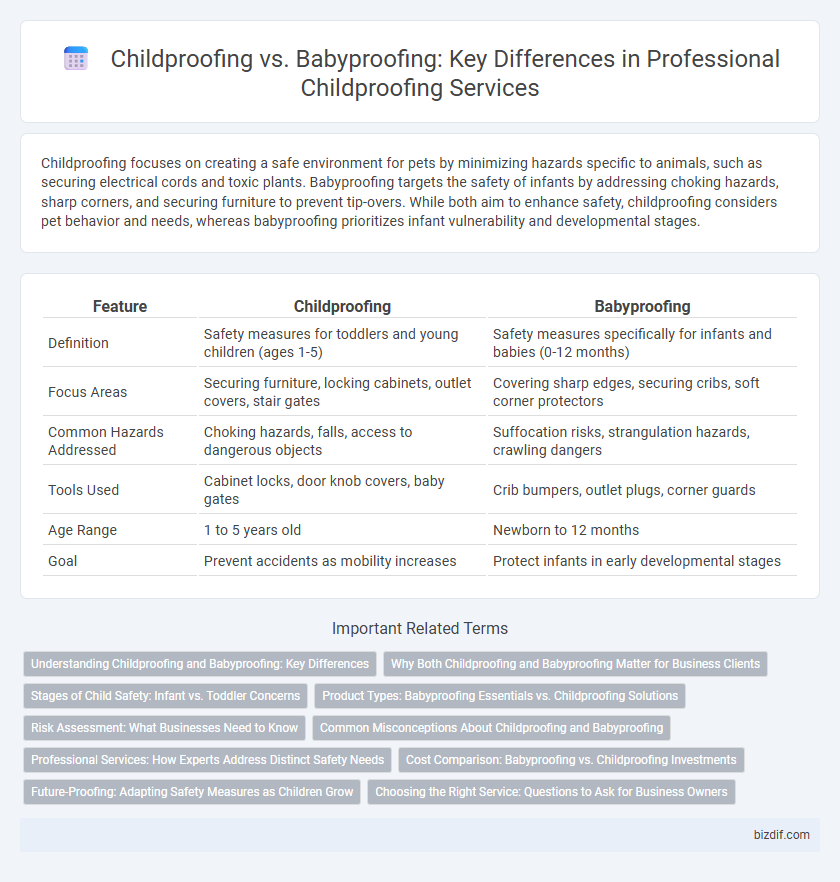Childproofing focuses on creating a safe environment for pets by minimizing hazards specific to animals, such as securing electrical cords and toxic plants. Babyproofing targets the safety of infants by addressing choking hazards, sharp corners, and securing furniture to prevent tip-overs. While both aim to enhance safety, childproofing considers pet behavior and needs, whereas babyproofing prioritizes infant vulnerability and developmental stages.
Table of Comparison
| Feature | Childproofing | Babyproofing |
|---|---|---|
| Definition | Safety measures for toddlers and young children (ages 1-5) | Safety measures specifically for infants and babies (0-12 months) |
| Focus Areas | Securing furniture, locking cabinets, outlet covers, stair gates | Covering sharp edges, securing cribs, soft corner protectors |
| Common Hazards Addressed | Choking hazards, falls, access to dangerous objects | Suffocation risks, strangulation hazards, crawling dangers |
| Tools Used | Cabinet locks, door knob covers, baby gates | Crib bumpers, outlet plugs, corner guards |
| Age Range | 1 to 5 years old | Newborn to 12 months |
| Goal | Prevent accidents as mobility increases | Protect infants in early developmental stages |
Understanding Childproofing and Babyproofing: Key Differences
Childproofing focuses on creating a safe environment for children of various ages by addressing general hazards such as sharp edges, toxic substances, and electrical outlets. Babyproofing specifically targets infants and toddlers, emphasizing protection against choking hazards, securing furniture, and installing gates to prevent falls. Understanding these distinctions helps parents implement age-appropriate safety measures tailored to their child's developmental stage.
Why Both Childproofing and Babyproofing Matter for Business Clients
Childproofing and babyproofing are critical for business clients to ensure a safe environment for children of all ages, reducing liability and enhancing trust with families. Childproofing focuses on hazards for older toddlers and children, while babyproofing targets infants' unique safety needs, making both essential for comprehensive protection. Investing in both services demonstrates a commitment to child safety, attracting clients who prioritize secure spaces for their children.
Stages of Child Safety: Infant vs. Toddler Concerns
Childproofing targets infant safety by securing sharp edges, outlet covers, and cabinet locks to prevent hazards during early mobility stages. Babyproofing expands these measures to address toddler-specific risks such as furniture tipping, stair gates, and choking hazards from small objects. Understanding the distinct stages of child safety ensures tailored protection for infants who are crawling and toddlers who are exploring their environment more actively.
Product Types: Babyproofing Essentials vs. Childproofing Solutions
Babyproofing essentials primarily include basic products such as outlet covers, corner guards, and cabinet locks designed to protect infants from common household hazards. Childproofing solutions extend beyond these basics to incorporate advanced safety devices like stair gates, furniture anchors, and window guards tailored for older toddlers and preschoolers. Selecting appropriate products ensures comprehensive safety by addressing the evolving mobility and curiosity levels of children as they grow.
Risk Assessment: What Businesses Need to Know
Childproofing and babyproofing both aim to enhance safety but differ in scope; childproofing addresses hazards for toddlers and older children, while babyproofing targets infants specifically. Businesses must conduct thorough risk assessments that identify potential dangers like sharp edges, toxic substances, and unsecured furniture to ensure comprehensive safety measures are in place. Understanding these distinctions helps businesses implement tailored safety protocols compliant with regulations and reduce liability.
Common Misconceptions About Childproofing and Babyproofing
Childproofing and babyproofing are often used interchangeably, but childproofing generally covers safety measures for toddlers and older children, while babyproofing specifically targets infants who are just beginning to explore their environment. Common misconceptions include the belief that babyproofing appliances alone is sufficient for all child safety needs, neglecting the importance of securing furniture and eliminating choking hazards for older children. Effective childproofing requires a comprehensive approach tailored to the child's developmental stage to prevent accidents and ensure a safe living space.
Professional Services: How Experts Address Distinct Safety Needs
Professional childproofing services tailor safety solutions to different age groups, recognizing that childproofing typically involves securing homes for toddlers with features like cabinet locks and corner guards, while babyproofing focuses on infants and requires softer, more gentle safety measures such as crib padding and outlet covers. Experts perform comprehensive risk assessments identifying hazards unique to each developmental stage, ensuring customized installations that prevent injuries effectively. These specialized approaches maximize safety by blending advanced materials with precise placement based on child behavior insights and current safety standards.
Cost Comparison: Babyproofing vs. Childproofing Investments
Childproofing generally involves a broader and more comprehensive range of safety measures compared to babyproofing, resulting in higher overall costs due to extensive modifications like securing furniture and installing safety gates. Babyproofing, focused on infants, typically includes essential items such as outlet covers and cabinet locks, making it a more affordable initial investment. Evaluating the long-term expenses reveals childproofing offers greater protection, potentially reducing future injury-related costs despite the higher upfront price.
Future-Proofing: Adapting Safety Measures as Children Grow
Childproofing focuses on creating a safe environment for toddlers by addressing hazards specific to their early developmental stages, while babyproofing targets infants' safety needs. Future-proofing involves continuously adapting safety measures as children grow and their motor skills and curiosity expand, ensuring protection against evolving risks. Implementing adjustable locks, modular safety gates, and versatile outlet covers allows for seamless updates in child safety infrastructure over time.
Choosing the Right Service: Questions to Ask for Business Owners
Childproofing and babyproofing both aim to create safe environments but differ in scope; childproofing covers broader age ranges and hazards, while babyproofing targets infants specifically. Business owners should ask if the service includes hazard assessments for various age groups, customization based on the child's developmental stage, and compliance with safety regulations. Evaluating the provider's experience, certifications, and use of non-toxic, durable materials ensures selecting the right childproofing service that effectively minimizes risks.
Childproofing vs Babyproofing Infographic

 bizdif.com
bizdif.com